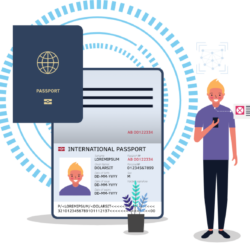Making identity checks according to likely risk

Our expert team here is often asked lots of questions about the details of false identity documents, around how they are manufactured and distributed and what happens when they spot one (top advice here). But businesses are generally most interested in how sophisticated the false ID documents are that are used to try and gain employment, access an organisation’s services or commit fraud. So, in this blog, we’re going to talk about the quality of false documents that our client helpdesk encounters and how our ID checking systems can help according to the likely level of risk.
Evaluate your risk
Firstly, the quality of fake documents seen is dependent upon several factors, but at the heart of these will be the risk profile of the business concerned. In another of our blogs, we highlighted the top 5 industry sectors where our clients had found false documents in 2018, which included construction and medical recruitment. It is very unlikely that anyone presenting false documents in those sectors, for example to gain employment as a construction labourer or carer, can afford highly sophisticated false documents, which, as shown by numerous press reports, will command a premium price. The highest referring sectors were mostly involved in the employment of low-cost labour and as such, the false documents presented and discovered were of a low quality.
Of course, the reverse can be said in a counter fraud environment, where depending upon the type of product concerned and method of application, a higher quality document may be presented, for example, to commit mortgage fraud or open a bank account with a view to money-laundering. In that environment, a fraudster will expect stringent controls and may not risk lower-quality documents. And therefore, the level of checks required to validate these ID documents will be much higher.
Low quality identity documents
The next logical question when our customers spot these low-quality documents is how someone has managed to travel on such poor-quality identity documents. However, most of the false identity documents that we see daily are unlikely to be used to travel across borders: the risk of using these documents in that rigorously checked environment is just too high for the person in possession of them. Our experience shows that lower quality documents used to apply for employment are likely to be manufactured within the UK and are not intended to pass travel checks. And it’s likely that the criminals who manufacture and supply the documents, specifically in areas of low-cost labour, are hoping that minimal, ‘copy and file’ type checks will be made, or even no checks at all, which will allow their holder to easily gain employment.
So, for fake identity documents which are low quality, do you really need to use ID checking software to spot them?
Well, if you’re presented with tens or hundreds of documents every month, potentially across visa, passports, ID cards and BRPs purporting to be issued in dozens of different countries, it’s tough to be an expert on each of them. How would you know a genuine document from a fake one, even if the quality of the fake is poor? The highly-trained team here would spot it immediately – we’d like to think. However, if your recruitment teams don’t have border-force or police experience and they’re not seeing hundreds of fakes every year, then spotting a fake ID by eye, even if it is poor quality, is no easy task.
What’s more, it’s a legal requirement for every UK employer to make Right to Work checks and the cost of non-compliance can be significant. But compliance shouldn’t be complex and expensive. And it shouldn’t require your team to turn into detectives. Visually checking documents, investigating possible fake documents, keeping records for audit purposes and training staff can be expensive for a business.
But a simple automated check, such as the service we offer on TrustID Cloud, is a really easy way to check a document, give you peace of mind and reduce your risk. It offers a far greater quality of check than a visual check alone for a small cost and very little training.
Of course, if you see your customers and applicants in a single location or are in an environment where your risks are high, such as the previously mentioned counter fraud scenarios, you might prefer to consider the highest level of document checking, with an electronic ID scanner like the ones you see at the Border. Again, it’s all about balancing your risk…
Conclusion
In 2017 and 2018, most of fake identity documents found by our customers were detected with our online Cloud ID checking service; this is our entry-level checking service.
Based on our customer evidence over the past 24 months, we believe that private sector organisations employing lower-skilled labour or recruiting a dispersed workforce in a high-turnover environment won’t usually see highly sophisticated identity documents. The lower quality fake IDs that they will see are most-likely to have been produced in country, and don’t require sophisticated validation – they will be more easily and reliably identified by using a first line electronic checking service in the Cloud than by visual inspection alone.
Want to find out more?
Our online validation service can help you with compliance by making quick, consistent checks on applicants for as little as £1 per check. Why not find out how we could help you?
Checks mean you can be sure
Sign up to receive updates
Receive notifications from TrustID direct to your inbox. Simply fill out your email address in the form below.
Want to find out more?
We’d be really happy to chat through your requirements and offer advice on the best service for your business.
Tel: 0118 466 0822 or email us.
Request a callback


